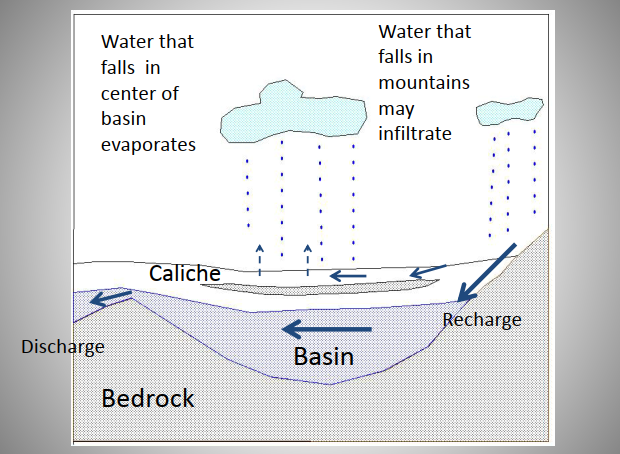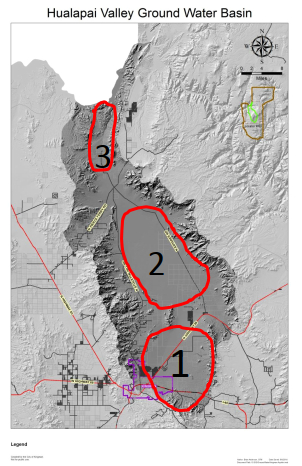Mohave County Water - Luis Vega Date: 3/2015
MOHAVE COUNTY WATER
HOW WE KNOW WHAT WE KNOW
Water studies by
United States Geological Survey USGS
Arizona Department of Water Resources ADWR
(ADWR website has copies of reports)
http://www.azwater.gov look under Data-Hydrology E-Library
Private developers for Water Availability
These studies give us a starting point for
decision making.
They give us:
- Approximate amount of available water
2. Existing water budget - how much water is taken out and how much is put back
(Recharge / Discharge)
3. A model for the impacts as water is taken out.
Estimated volume of recoverable groundwater for Hualapai Valley Groundwater Basin (data from ADWR OFR # 11)
| Specific Yield | Specific Yield To 1,200 feet | To 1,500 feet | To 2,000 feet |
| 3% | 3,800,000 | 5,000,000 | 5,600,000 |
| 6% | 7,600,000 | 10,100,000 | 11,100,000 |
| 8% | 10,100,000 | 13,400,000 | 14,800,000 |

Hualapai Basin Water Budget
(from USGS Study SIR2013-5122 with additions)
(Kingman Farms not included- amounts unknown)
| Natural Recharge | In AcFt/Yr | Out AcFt/Yr |
| Mtn-block recharge | 4,400 | |
| Stream recharge | 1,000 | |
| Underflow into basin | 300 | |
| Natural Discharge | ||
| To Lake Mead | 5,700 | |
| Evapotranspiration | 200 | |
| Incidental recharge | 4,300 | |
| Groundwater withdrawals | ||
| Kingman municipal | 8,900 | |
| Community supplies | 500 | |
| Self-supported domestic | 500 | |
| Interbasin transfer | 1,200 | |
| Sub-totals | 10,000 | 17,000 |

Hualapai basin can be thought of as a3 bath tubs each filled with sand, gravel and water separated by bedrock highs.
Sub-basins
- Kingman (Airport)
- Red Lake
- Gold Basin
| Outside of AMA | INA | AMA | |
| Uses of water | Water pumped for beneficial use |
Water pumped for beneficial use |
Limited to meet goals of safe-yield |
| Grandfathered rights | No grandfathering | Irrigated land grandfathered |
Water rights are grandfathered |
| Who controls the water | Must follow state-wide regulations |
Must follow state- wide regulations |
Managed by ADWR |
| Irrigation | No regulations | No new irrigation allowed |
No new irrigation allowed |
| Monitoring of wells | No measuring devices required on wells | Measuring devices required on non-exempt wells | Measuring devices required on non-exempt wells |
| Reporting | No reporting required | Annual reports required from non- exempt wells |
Annual reports required from non- exempt wells |
| Conservation | No mandated conservation requirements |
No mandated conservation requirements |
Mandated conservation requirements |
Active Management Areas (AMAs)
In the Phoenix, Prescott, and Tucson AMAs, the primary management goal is safe-yield by the year 2025.
Safe-yield is accomplished when no more groundwater is being withdrawn than is being annually replaced.
What would be the management goal for the Hualapai Basin if it were made an AMA?
A decision to pursue a course of action should take into account Unintended consequences.
Disadvantages of AMA in Hualapai Basin:
1. What would the goals of an AMA be?
A. Hualapai Basin is already in a deficit.
B. No new surface water available, such as the
CAP.
C. Safe-yield (use = recharge) cannot be attained even by stopping growth.
2. Management of water resources would be under ADWR control.
3. Monitoring of groundwater and conservation measures can be accomplished by the County and not relegated to ADWR.
Advantages of an INA in Red Lake Sub-basin:
1. A limit on land being irrigated would be immediately placed by the Director of ADWR upon receiving petition.
2. Kingman growth would be possible because the 100yr assured water supply requirement could be met.
3. ADWR would not be able to limit the use of water in Mohave County.
4. Non-exempt wells would have to be monitored and water use reported to ADWR
What is the future of Hualapai Valley?
•Groundwater is being mined. Without other sources, the Hualapai aquifer will run dry.
•Stop low priority, high volume uses of water-(agriculture).
•Improvements in aquifer recharge are needed - capture all runoff into recharge ponds.
•Water conservation measures should be implemented by the County but conservation cannot meet total needs.
•Must secure other sources of water (coordinated with other states, possibly through Colorado River or ?).


